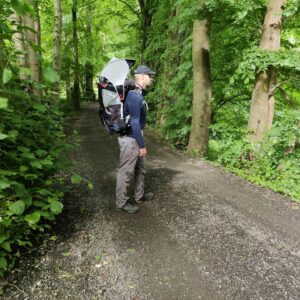Hiking can be as easy and uncomplicated as a walk in the nearby park but as soon as you are going on a hike that will take place on terrain you don’t know, some planning is required. That way you’ll get information about the technical complexity of the trail, expected weather conditions and a feeling of the area where you’ll hike. This information will help you to pack the right equipment and avoid problems with navigation. In the following, we have described the nine steps to undertake before going on a hiking trip.
You should go through these nine steps at least 1 day before the hiking trip takes place.
Table of contents:
- Plan the route
- Plan the journey to the starting point
- Check what temperatures to expect
- Check what precipitation to expect
- Check what vegetation and ground cover to expect
- Check if there is water available
- Check how long the day will be
- Check if there are any dangerous animals
- Check if there are any other natural hazards
Plan the route
The first step of planning any hiking trip, is to get as much information about the trail you chose as possible. Search for information online (forums and blogs for example) and check on Wikiloc, Gaia GPS and AllTrails for GPS tracks. Checking these hiking portals is also a great way to find trails near your location. GPS tracks are very useful because they do not only show detailed information such as ascent, descent and distance, but can also be downloaded and imported to a handheld GPS device, GPS watch or simply a smartphone. This makes navigation much easier as the trail and your location on it can be seen at any time. Read more about GPS tracks in our article What are GPS tracks and how to use them for hiking. However, it’s always a good idea to have a printed map (especially on long and not well-marked hiking trails) because electronic devices are not 100% reliable. The battery can run out, the GPS signal is unavailable etc. It is also possible that the trail has changed due to natural phenomena such as landslides, flash rivers etc. In most cases you can buy printed maps of the area online or at any tourist office.
When you have the route planned, it’s very important that you calculate the approximate time that you will need to finish it. Take distance, total ascent and your physical preparedness into consideration when determining the required time. If you are going with others, keep in mind that the required time has to be based on the least fit person in the group.
Plan the journey to the starting point
After you planned the route, it’s time to plan the journey to the starting point, i.e. the point where you start hiking (parking place, bus stop, train station etc.). Starting points are often remote and thus difficult to reach. Search for information online (forums, blogs), and check bus/train schedules and/or parking possibilities. If you decide to go by car, keep in mind that some roads might require a 4×4 vehicle.
Check what temperatures to expect
If you are planning the hike shortly before it will take place, you can simply check the weather forecast. Sometimes it’s hard to get temperature data for remote locations; if this is the case, check the temperature data from the nearest weather station. Then calculate the altitude difference between the weather station and the hiking area as the temperature decreases with altitude – approximately 6.5° C (11.7° F) for every 1000 meters (3280 ft). If you are planning the hike long before it will take place (when for example planning a hiking holiday abroad), search for temperature averages online. Choose your apparel and gear according to the expected temperatures, but as close to the hike as possible in case of slightly different weather, for example a milder or colder spring which can influence the likelihood of (old) snow.
Check what precipitation to expect
You can get an idea of how much precipitation to expect from the weather forecast or historical precipitation data. Pack your gear according to expected precipitation. If you expect high precipitation, bring more clothing with you (in addition to waterproof gear) so that you have something dry to change into if your clothes get completely soaked.
Check what vegetation and ground cover to expect
Information about vegetation and ground cover can be acquired from maps, satellite imagery and by searching forums and blogs online. Finding information about the ground cover is especially important when there is a chance that the trail is covered with snow. If so, you will need appropriate footwear and equipment like gaiters, crampons and ice axe.
Check if there is water available
When planning a hiking trip, check if there are any sources of drinkable water along the trail. If there are, you can eliminate some of the load that you’ll be carrying by refilling your bottles/hydrations system along the trail. If you are not sure how much water you need, check out our article How much water to bring on a hiking trip.
Check how long the day will be
In many cases daylight is not a problem – you can easily hike 8 or more hours without using a flashlight or a headlamp. However, if you are hiking far away from the equator (Iceland for example) in winter, you should expect that the daylight period will be significantly shorter. Therefore, you will need a powerful light (preferably a headlamp) so that you can efficiently hike in darkness. Sunrise/sunset times for every major city can be found on the TimeAndDate website, so you can plan the hike accordingly.
Check if there are any dangerous animals
In case that there are dangerous animals like bears, snakes and spiders in the area where you plant to hike, some additional caution is required. Information about dangerous wildlife can be accessed online – check government websites, blogs and forums.
Check if there are any other natural hazards
When you plan a hiking trip, it is important to be familiar with natural hazards in the area where you’re planning to hike. Most common natural hazards are avalanches, floods and falling rocks. Information about these hazards can be in most cases accessed on government websites, forums and blogs.
I’d love to hear your thoughts on how to plan a hiking trip. Write them in the comments section below.





















